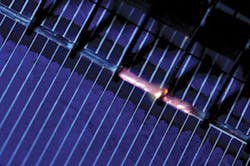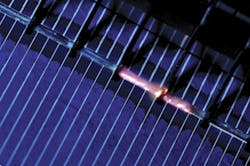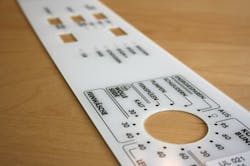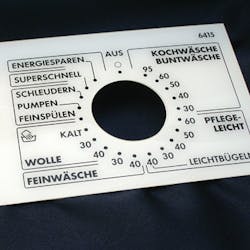Laser choice offers cost advantages in the solar industry
Aachen, Germany - Competitive process engineering for the production of electronic components calls for high speeds, small structure sizes, and large-scale applicability. In organic electronics, structured printing currently allows feature sizes as small as 10 μm at high speeds. A significantly higher resolution and productivity can be obtained with structuring by laser. Especially important here is choosing a laser that is ideally suited to the requirements of the particular application.
"Most companies in the solar industry don't know how much time and costs they can save by using the right laser for manufacturing thin-film solar modules or crystalline solar cells," explains Dr. Malte Schulz-Ruthenberg, project manager at Fraunhofer ILT. "For example, completely different beam guiding and shaping approaches are required for high-speed drilling of back-contact solar cells than those used to create complex structures on electronic circuits at high processing rates."
Consequently, researchers at Fraunhofer ILT are investigating different approaches to improve process efficiency in a range of different projects. One of these projects is exploring the possibility of multiple beam splitting using diffractive optical elements, which can dramatically increase production throughput rates. A polygon scanner is also being developed that enables 2-D structuring of thin layers at extremely high speeds of several hundred meters a second. Combined with modern beam sources working at high repetition rates, the polygon scanner can significantly increase production throughput. It can be used for processing both thin-film solar modules and crystalline solar cells.
Additionally, ILT is developing structuring processes for thin-film solar modules, which are small strips of cells connected in series to reduce current densities, which in turn reduce electrical losses within the module. What many companies are doing by means of mechanical scribing can be done quicker and more cleanly by means of laser radiation. The challenge ILT researchers now face is to do this without impairing the functionality of the layers of conducting, semiconducting, or insulating materials, which have thicknesses ranging from a few nanometers to a few micrometers. If, for example, residues of ablated material or thermal damage to neighboring areas occur during processing, the extreme thinness of these layers can lead to their degradation and cause the entire solar module not to work. The laser structuring processes therefore have to be adapted to the different characteristics of each individual layer. Ultrashort pulse lasers can be used for physical processes that are not feasible at longer pulse durations. This opens up new process windows, and paves the way towards new industrial-scale processes.
In FlexLas, a project funded by the European Commission and the state government of North Rhine-Westphalia, a laser structuring technique for organic solar cells on flexible film substrates is being developed at ILT. This type of solar module is considered an economical, forward-looking product in the field of solar energy. It might well be possible one day to make textiles or handbags with flexible solar cells, which could be used to charge a cell phone. The laser structuring processes being developed can also be applied to other products with multiple-layer systems, such as smart phone screens and flat lighting elements.
ILT is working on a variety of laser processes for manufacturing crystalline solar cells, such as a technique that allows drilling of upward of 10,000 holes/sec. into silicon wafers. Thin passivation layers can be removed with scarcely any effect on electrical functionality. And thanks to innovative beam-shaping optics, laser-based module manufacturing drives soldering times down to less than a second.
Using the right beam source here can significantly improve the production process. ILT researchers are testing a variety of different beam sources to fulfill the widest possible range of parameters, such as those relating to pulse duration, wavelength, and process-adapted intensity distribution, while minimizing laser-related damage. The researchers are devising innovative approaches to producing high-efficiency cells.
For more details, contact: Dr. rer. nat. Malte Schulz-Ruthenberg ([email protected])
Polycarbonate films in the 'white goods' sector
Lüneburg, Germany - The 'white goods' sector includes household appliances such as washing machines, refrigerators, dryers, and all kinds of kitchen appliances. For these electrical devices, high-quality films are often required to embed actuators and displays. The printed films are usually back-injected with plastic and thus stiffened.
Polycarbonate (PC), also known as Makrolon®, Anjalon®, or Durolon®, is a material commonly used in front foils for touch panels, indicating instruments, or even colorfully printed front panels and speedometers. Foils made of this synthetic can be processed with the laser up to a material thickness of 3 mm.
Eurolaser has demonstrated how a front panel is cut from polycarbonate using a laser, with particular attention being paid to the openings for switches, controls, and LEDs. which must be cut very accurately to provide a high standard of quality.
The demands on the films, mostly made of PC, ABS or PETG, are very high. A good level of impact and scratch resistance is a prerequisite. As a result, the demands made on the processing of such a complex material are extensive. The advantages of laser cutting are:
• Accurate laser cutting of printed materials in particular due to an optical recognition system;
• No force applied to the material - therefore no mechanical stress of the material;
• Highest precision and great advantages in filigree cuttings; even small batches become economically viable;
• Most used material in the fields of membrane keyboards and front panels; and
• Processing of premounted multilayer function panels.
Many applications require an accurate cutting oriented to existing fiducial marks or other material references. As a response to this need eurolaser offers an solution consisting of a CCD camera and analysis software. This optical recognition system positions the laser beam according to fiducial marks.
The advantage of laser processing, as opposed to a punch or cutter, is the high quality of the split cut, as well as the nonexistent wear to the 'laser' tool. With the laser beam, even the smallest details can be cut practically radius-free, unlike with a cutter. Noncontact processing has the advantage of not affecting material surfaces. In addition, the material need not be laboriously fixed, leading to reduced production times. Laser processing also offers:
• Compensation for shrinkage, stretching and twists in the material;
• Faster processing speed together with high process reliability and short machine setup times;
• Workflow manager for automation of workflow from the import to the output of job files; and
• A high-performance nesting function for optimal area usage and minimised material consumption.
For more details, contact Susanne Wölkl ([email protected]).
Correction:
In the September/October Update item on marking stainless steel, ILS inadvertently misspelled the company name; it should be Fimark Ltd. www.fimark.com.



